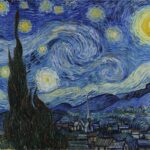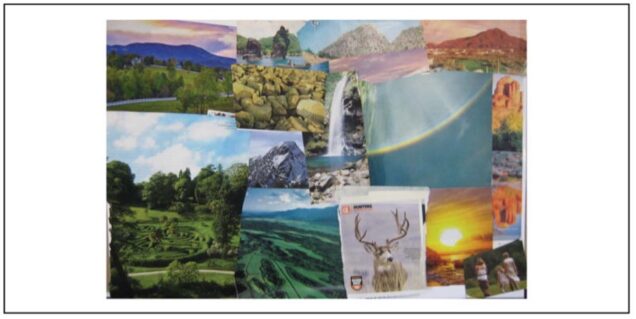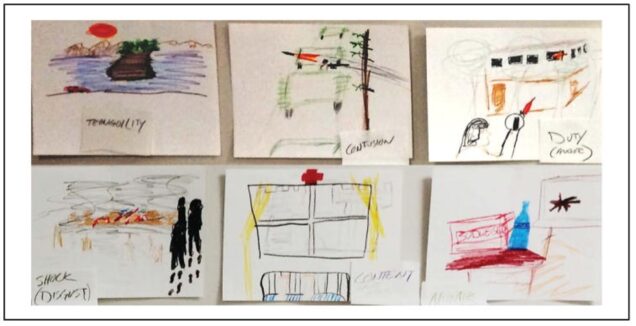Art as Therapy

“You gotta resurrect the deep pain within you and give it a place to live that’s not within your body.
Let it live in art. Let it live in writing. Let it live in music.
Let it be devoured by building brighter connections.
Your body is not a coffin for pain to be buried in. Put it somewhere else.”
– Ehime Ora
There are many modalities that can be helpful in the treatment of trauma. This post explores the benefits of creative expression as self-care and treatment using a specific and personal example – my mom. More than prescribed ‘art therapy’, the use of art as a therapeutic form of self-expression has helped my family in many ways. Because it is relevant to this story, I will preface this with a context of culture and history.
My mom suffers from PTSD and many physical ailments. There are many parts of her life she is just now correlating with trauma and others she may not remember yet. I inherited parts of her trauma and quickly assimilated into American culture; I was a child when we emigrated. We came to America at an inflection point of its contentious relationship with Iran, a country on the precipice of Revolution. Being a young mother, she left behind home and family for her safety and that of her child. I remember hearing bombs fly overhead while speaking on the phone from the U.S. with my grandparents in Iran during the Iran-Iraq War. We heard and saw much war and death and many loved ones were lost.
Iran is a tumultuous, beautiful, democratic (at its roots), tyrannical, dangerous, powerful country. We are born from the soil of mixed contradictions, rich with historically significant contributions to mankind. Persians were originally of a monotheistic religion called Zoroastrianism, and hail from one of the oldest empires in history. This beautiful land, like any other, is filled with generational trauma.
In recent times, you may have heard the name ‘Mahsa Amini’, one of countless young people killed by a brutal regime for no reason. That trauma runs deep and wide, we felt it here in America and around the globe; it is directly contributory to pain we feel today (physical and otherwise). We protested the oppression and brutality; we donated, cooked, sang, cried, and rallied. It is difficult to process that much grief for that much death alone, so we feel strength in numbers, and we express that grief in artistic ways. Musicians write anthems, writers pen poems and novels, actors appeal on screens, we cook for and comfort each other. Integral to processing trauma, and to our culture, is art and expression. We are a traditional, communal people so our form of therapy usually revolves around community. It is not uncommon to see a group of Persian friends at a restaurant crying, laughing, eating, and crying some more. We express as much trauma as we hold. This is also common for other cultures around the world.
There are many different, effective ways to use creative expression as a form of self-care and treatment.
Dance Therapy
We learned from Bessel Van der Kolk that (in 2014) there was little known about how artistic forms of therapy “work or about the specific aspects of traumatic stress they address”. Kolk discusses some of the ways that artistic therapies have been measured and produced either disappointing or inconclusive results.
One form of dance therapy paired “nonverbal artistic expression with writing” by social psychologist James Pennebaker and dance/movement therapist, Anne Krantz. The study group that danced then wrote about a traumatic experience showed “better physical health and improved grade-point average. (The study did not evaluate specific PTSD symptoms.)”. Interestingly, when considering just writing therapy that focused on PTSD symptoms, it seems they were less successful when done in “group settings where participants were expected to share stories.” (Kolk, 2014, p.354). Sharing vulnerable thoughts and feelings publicly before readiness can feel more traumatic than healing.
Art & Creativity
Where culture or innate expression may not be a factor for everyone, traditional art therapy is a useful clinical approach:
“Characteristic for art therapy is the methodical use of art means as drawing, painting, collage, and sculpting to shape and express feelings, thoughts, and memories. Art therapy is distinguished from other forms of treatment by active performing and experiencing with art materials, by the visual and concrete character of the process as well as by the result of art making.” (Schouten, et al., 2015).
“Art safely gives voice to and makes a survivor’s experience of emotions, thoughts, and memories visible when words are insufficient.” Art and creativity can tap “into other parts of a person’s experience. It accesses information … or emotions that maybe can’t be accessed through talking alone … Using art therapy to treat PTSD addresses the whole experience of trauma: mind, body, and emotion.” (Fabian, 2019).


Studies have been conducted showing the effectiveness of different forms of art therapy (seen in these examples above) in combination with cognitive therapy for combat veterans with PTSD. “Art therapy may assist with integration of sensory memories and declarative memory and has been shown to reduce symptoms of PTSD in a number of populations.” (Campbell, et al., 2016). They found that “Art therapy in conjunction with CPT was found to improve trauma processing and veterans considered it to be an important part of their treatment as it provided healthy distancing, enhanced trauma recall, and increased access to emotions.” (Campbell, et al., 2016).
Putting it Together
Integrating any type of art or creative expression into trauma therapy is an individual choice. There have been promising studies showing valuable contributions to the treatment of PTSD, enhanced by combining other treatments. Addressing trauma is complex since it can remain hidden in our bodies and minds, so “using a combination of traditional therapy techniques and alternative treatments such as EMDR, yoga, neurofeedback, and theater, patients can regain control of their bodies and rewire their brains.” (Kolk, 2014, p.1).
For my mom, art has been helpful and productive as a form of self-care and adjunct to other therapies. Used in conjunction with other treatments, it takes on a calming, meditative quality that stills her mind and body. Joining treatments has helped unlock complex trauma that was hidden from her. This very personal, internal processing does not involve verbal expression, but emotion and thought come through as a physical creation. It is a form of healing during times when she struggles to identify where her trauma resides. Her creations are freehand, and it is in the moment of pure, joyous, creative expression that she does her best work. By her own account, when she is creating, she is ‘lost in Zen space’ with no concept of time, pain, or physical body. I believe it is in this space that she reconnects with her body and mind in a safe space.
Helpful as PTSD treatment, art “therapies can be helpful in reducing depression and trauma-related symptoms such as alexithymia, dissociation, anxiety, nightmares, and sleep problems… increasing emotional control, improving interpersonal relationships, and improving body image (Johnson & Lahad, 2009).” What is lacking from all articles on the efficacy and full benefits of PTSD treatment, however, appears to consistently be a lack of “robust information on their effectiveness”. It is possible that there have not been any ‘robust’ studies because art can take many forms, is highly subjective and contextual in nature, and is difficult to systematically analyze. From personal experience, I can say that art (in all forms) has been a healing, therapeutic tool for my family. I cannot imagine our lives without it.
References
Campbell, M., Decker, K. P., Kruk, K., & Deaver, S. P. (2016). Art Therapy and Cognitive Processing Therapy for Combat-Related PTSD: A Randomized Controlled Trial. Art therapy : Journal of the American Art Therapy Association, 33(4), 169–177. https://doi.org/10.1080/07421656.2016.1226643
Schouten, K. A., de Niet, G. J., Knipscheer, J. W., Kleber, R. J., & Hutschemaekers, G. J. (2015). The Effectiveness Of Art Therapy In The Treatment Of Traumatized Adults: A Systematic Review On Art Therapy And Trauma. Trauma, violence & abuse, 16(2), 220–228. https://doi-org.ezproxy.bu.edu/10.1177/1524838014555032
Debruge, P., Earl, W., Gleiberman, O., Moreau, J., Murphy, J.K., Saperstein, P., Shafer, E., Shanfeld, E., Seo, R. The 30 Greatest War Films. Variety.
https://variety.com/lists/best-war-movies/
Van der Kolk, B. A. (2014). The Body Keeps The Score: Brain, Mind, And Body In The Healing Of Trauma. Penguin. Amazon Kindle version.
Fabian, R. (2019, Aug 13). Medically reviewed by Legg, T.J., PhD, PsyD. Healing Invisible Wounds: Art Therapy and PTSD. Healthline.
Art & Talk Therapy. Retrieved on 2023, Aug 15 from https://www.aactherapy.com/art-therapy
Also referenced from: Ora, E. (2023, July). Ancestors Said: 365 Introspections for Emotional Healing. 1st ed. Hay House, Inc.